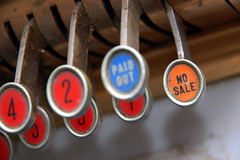Even the most experienced marketers can mess up a landing page. Sometimes, it’s trying to meet a tight deadline. Other times, there are too many people (client, designer, writer) clamoring to make changes.
On other occasions, it’s simply being “too close” to the project. When you know how everything is supposed to work, it can be hard to realize that an outsider could easily be confused or distracted.
Here are ten key things that can mess up your landing page (and how to fix them).
1. Lots of other content
I just looked at a landing page with links to sub-topics. blog archives, top posts, and a store. It also featured ads for other products, some of them animated. It was confusing and distracting.
Make your landing page distraction-free. Remove all the navigation links, the link to your blog, anything that isn’t absolutely necessary. Some people even make the landing page its own domain.
2. Sharing buttons
Sharing is great, but it’s not your first priority for a landing page. You want people to take a specific action (buy something, or sign-up). Don’t distract them with Twitter links. They buy from the landing page, not Facebook. You may get a new Twitter follower or two, but that’s not a sale.
3. RSS feed
Sure you want more subscribers to your blog, but this isn’t the place for it. You want to zero in on one thing – getting more people to download your book and subscribe to your newsletter.
4. What’s in it for me?
I saw a blurb recently with information about the sources for an e-book’s content, but very little about what that content actually was. Tell readers why they will want to read what you wrote. What will they get from it?
5. Dull title
Calling your book “Dinner menus” won’t attract much interest. Instead call it “Dinner in 30 Minutes.” The title should attract attention, arouse curiosity, and encourage readers to want to learn more.
6. Too vague
Share some hints about what’s inside. Continuing with the cooking theme (I must be hungry), list some of the recipes: Chicken in Basil Cream, Almond-Coated Trout with Sage, Linguini with Pesto Sauce. Be as specific as possible (without giving everything away).
7. No authority
Be clear about your credentials to discuss and advise on the topic. In this case, it might be parent of three children, or testimonials from previous subscribers about your great recipes.
8. Ads for irrelevant products
A banner ad for car insurance won’t help you get subscribers to your Android apps newsletter. Neither will your twitter stream or recent blog comments. Keep those things for your normal blog pages (not landing pages).
9. No clear audience
Who is this for? The likely audience for our hypothetical cooking ebook is busy moms. Talk in terms that will appeal to them.
10. No benefits
Tell them why they need this book. “Get dinner on the table fast. Delicious, quick meals your kids will actually eat. And, they’re so good, you’ll love them too. No more making separate dinners for each member of the family.”




